Nanostructured titanic acid salts and preparation process and use thereof
a technology of nanostructured titanic acid salt and preparation process, which is applied in the direction of alkali titanates, cell components, electrochemical generators, etc., can solve the problems of low purity, inability to obtain optimal application effect of titanic acid salt material, and low purity, so as to achieve easy large-scale industrial production, simple preparation process, and easy control of process parameters
- Summary
- Abstract
- Description
- Claims
- Application Information
AI Technical Summary
Benefits of technology
Problems solved by technology
Method used
Image
Examples
example 1
[0066]According to the process shown in FIG. 1, under stirring, 4 g of titanium isopropoxide was dispersed in 100 ml of water, and then 8 ml of 30% hydrogen peroxide was added thereto under stirring to form a suspension containing titanium peroxo-complex. Next, 10 g of sodium hydroxide was added to the above suspension of peroxo-complex under stirring to form a pale yellow transparent solution. Next, 30 ml of ethanol was slowly added to the transparent solution under stirring at room temperature to obtain a one-dimensional nanowire precursor precipitate, which was separated by filtration to obtain sodium titanate precursor precipitate. The SEM image thereof is shown in FIG. 2. Subsequently, the precursor precipitate was dried, and then heated at 300 degrees Celsius for 24 hours to obtain a one-dimensional nanowire sodium titanate product. The SEM image thereof is shown in FIG. 3.
[0067]FIG. 4 is a curve showing the results of the cycle performance test of the sodium ion battery using...
example 2
[0068]According to the process shown in FIG. 1, under stirring, 3 g of titanium isopropoxide was dispersed in 100 ml of water, and then 6 g of urea peroxide was added thereto under stirring to form a suspension containing titanium peroxo-complex. Next, 8 g of sodium oxide was added to the above suspension of peroxo-complex under stirring to form a pale yellow transparent solution. Next, 10 ml of isopropanol was slowly added to the transparent solution under stirring at room temperature to obtain a precursor precipitate, which was separated by suction filtration to obtain sodium titanate precursor precipitate. The SEM image thereof is substantially the same as FIG. 2. Subsequently, the precursor precipitate was dried, and then heated at 450 degrees Celsius for 4 hours to obtain a sodium titanate product. The SEM image thereof is substantially the same as FIG. 3.
example 3
[0069]According to the process shown in FIG. 1, under stirring, 1 g of tetrabutyl titanate was dispersed in 100 ml of water, and then 2 ml of 30% hydrogen peroxide was added thereto under stirring to form a suspension containing titanium peroxo-complex. Next, 2 g of sodium peroxide and 3 g of sodium chloride were added to the above suspension of peroxo-complex under stirring to form a pale yellow transparent solution. Next, 30 ml of methanol was slowly added to the transparent solution under stirring at room temperature to obtain a precursor precipitate, which was separated by centrifugation to obtain sodium titanate precursor precipitate. The SEM image thereof is substantially the same as FIG. 2. Subsequently, the precursor precipitate was dried, and then heated at 900 degrees Celsius for 1 hour to obtain a sodium titanate product. The SEM image thereof is substantially the same as FIG. 3.
PUM
 Login to View More
Login to View More Abstract
Description
Claims
Application Information
 Login to View More
Login to View More - R&D
- Intellectual Property
- Life Sciences
- Materials
- Tech Scout
- Unparalleled Data Quality
- Higher Quality Content
- 60% Fewer Hallucinations
Browse by: Latest US Patents, China's latest patents, Technical Efficacy Thesaurus, Application Domain, Technology Topic, Popular Technical Reports.
© 2025 PatSnap. All rights reserved.Legal|Privacy policy|Modern Slavery Act Transparency Statement|Sitemap|About US| Contact US: help@patsnap.com



